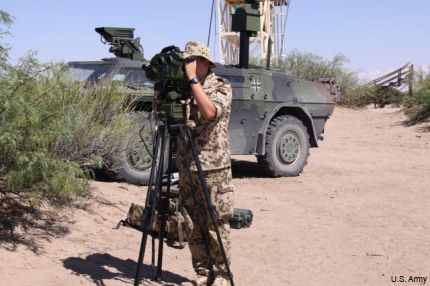Digital battlefield system puts multiple nations on the same page
The Army’s ASCA takes language out of the equation when coalition forces call for artillery support.

ASCA integrates the fire support systems of multiple nations into one interface.
The Army and units from six other countries recently demonstrated a digital battlefield support system that streamlined calls for artillery fire by taking differences in language—and how they designate locations—out of the equation.
In a live-fire demonstration at the Bold Quest 15.2 exercise based at Fort Bliss, Texas, forces used the Army’s Artillery Systems Cooperation Activities, or ASCA, to link seven different fire support command and control systems, improving both the speed and accuracy of artillery support.
ASCA provides a digital interface for linking those disparate, multinational systems, thus avoiding the delays and potential confusion that could result from calling for that support via radio, the Army said in a release. And in addition to removing any language barrier, the system also creates common points of reference.
"Some countries use a grid, others use latitude/longitude," said Cpt. Brian McCown, fire directions officer for the 4th Battalion, 27th Field Artillery Regiment at Fort Bliss. "With ASCA, that conversion is a lot easier now. We want to know our systems can communicate and this takes away that gap in time and allows us to communicate quickly.”
Bold Quest is a series of exercises sponsored by the Joint Chiefs of Staff intended to improve interoperability among joint U.S. forces and coalition partners. For the second straight year, Bold Quest was conducted in concert with the Army’s Network Integration Evaluation, which was staged Sept. 25 to Oct. 8 at Fort Bliss and the adjacent White Sands Missile Range and Holloman Air Force Base, both in New Mexico. In addition to U.S. forces, Bold Quest included participants from Denmark, Germany, France, Italy, Norway and the United Kingdom.
The software-based ASCA lets partner nations communicate automatically by linking their fire support command and control systems, without the need for additional hardware or separate systems, the Army said. Without it, units from each country would have to radio its calls for fire support, which could delay that support as well as introduce the possibility for human error.
"Interoperability is not just about technical issues," said Maj. Tor Steinar Bergset, a Norwegian army project officer. "It is also about [tactics, techniques and procedures], doctrine, trust and seeing how we operate. That's a big part of being interoperable."
ASCA, which integrates different national doctrines, languages, hardware and software, works with the Advanced Field Artillery Tactical Data System, or AFATDS, the fire support command-and-control system used by the Army and Marine Corps. The Army said it is working on the latest edition of AFATDS, which will work with its tactical battlefield network to bring its capabilities to forward observers, battalion fire support elements and fire direction centers.



